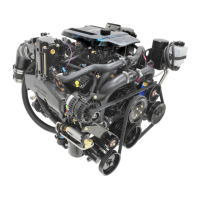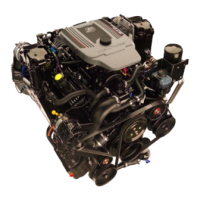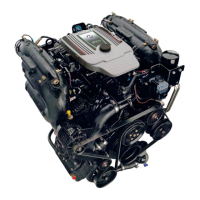4
CA280
Lanyard Stop Switch
74608
2
1
1 Some boats come equipped with a lanyard stop switch. A lanyard stop switch can also be installed as an acces-
sory. The purpose of this switch is to turn off the engine ignition whenever the operator (when attached to the lan-
yard) moves far enough away from the operator’s position to activate the switch.
2 The lanyard is a cord usually between 4 and 5 feet (1220 and 1524 mm) in length when stretched out with an
element on one end made to be inserted into the switch and a metal snap on the other end for attaching to the
operator. It is coiled to make its at rest condition as short as possible so as to minimize the likelihood of lanyard
entanglement with nearby objects. It is made as long as it is in its stretched condition to minimize the likelihood
of accidental activation should the operator choose to move around in an area close to the normal operator’s posi-
tion. If for any reason it is desired to have a shorter functional lanyard, this may be accomplished by using up length
in the way the lanyard and clip are attached to the operator (such as wrapping the lanyard around the operator’s
wrist or leg) or by tying a simple knot in the lanyard.
Read the Safety Warning on this page and the following page before electing to install, use, or not to use
such a switch.
!
WARNING
The following advantages and disadvantages of a lanyard stop switch should be considered before elect-
ing to use, or not to use, such a switch.
ADVANTAGES: The purpose of a lanyard stop switch is to stop the engine ignition whenever the operator
(when attached to the lanyard) moves far enough away from the operator’s position to activate the switch.
This would occur if the operator falls or moves within the boat a sufficient distance from the operator’s
position. This type of accident is most likely in certain types of boats such as low-sided boats, and high-
performance boats, It is also likely as a result of poor operating practices such as sitting on the back of
the seat at planing speeds, standing at planing speeds, operating at high speeds in shallow or obstacle-in-
fested waters, releasing your grip on a steering wheel that is pulling in one direction, drinking and driving,
or daring, high-speed boat maneuvers.
DISADVANTAGES: Inadvertent activation of the switch is also a possibility. This could cause any, or all,
of the following potentially hazardous situations:
1. Loss of balance and falling forward of unstable boat passengers - a particular concern in bow rider type
boats.
2. Loss of power and directional control in heavy seas, strong current or high winds.
3. Loss of control when docking.
While activation of the lanyard stop switch will result in immediate power shut-down, a boat can continue
to coast for some distance depending upon the velocity and degree of any turn at shut-down. However,
the boat will not complete a full circle. While the boat is coasting, it can cause injury to anyone in the boat’s
path as seriously as the boat would when under power.
As we cannot possibly know of and advise the boating public of all conceivable boat/motor types and/or
poor operating practices, the final decision of whether to use a lanyard stop switch rests with you, the own-
er/driver.
We strongly recommend that other occupants be instructed on proper starting and operating procedures
should they be required to operate the engine and boat in an emergency.
